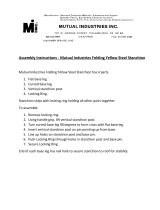Page is loading ...

INSTALLATION INSTRUCTIONS FOR ROOFING PERIMETER MARKERS
Above-ground construction areas, flat-roof jobs and open upper-level construction sites must be
flagged at not more than 6-foot (1.8 meters) intervals with high-visibility material.
They should be rigged and supported so that the lowest point (including sag) is no less than 34 inches
(0.9 meters) from the walking/working surface and its highest point is no more than 39 inches (1
meter) from the walking/working surface.
Stanchions, after being rigged with warning lines, shall be capable of resisting, without tipping over, a
force of at least 16 pounds (71 newtons) applied horizontally against the stanchion, 30 inches (0.8
meters) above the walking/working surface, perpendicular to the warning line and in the direction of
the floor, roof, or platform edge.
The rope, wire, or chain shall have a minimum tensile strength of 500 pounds (2.22 kilonewtons) and
after being attached to the stanchions, must support without breaking, the load applied to the
stanchions as prescribed above. They should be attached to each stanchion in such a way that pulling
on one section of the line between stanchions will not result in slack being taken up in the adjacent
section before the stanchion tips over.
Warning lines shall be erected around all sides of roof work areas.
When mechanical equipment is being used, the warning line shall be erected not less than 6 feet (1.8
meters) from the roof edge parallel to the direction of mechanical equipment operation, and not less
than 10 feet (3 meters) from the roof edge perpendicular to the direction of mechanical equipment
operation.
When mechanical equipment is not being used, the warning line must be erected not less than 6 feet
(1.8 meters) from the roof edge.
/




